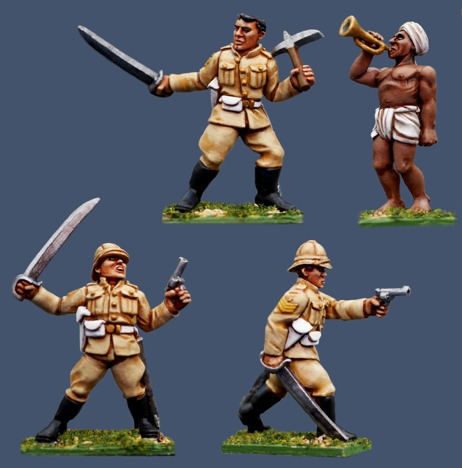There’s been a lot of excitement lately in the Colonial miniature wargaming world, thanks to the first pics being posted online of Bob Murch’s PULP FIGURES (CLICK HERE & JUMP TO HIS SITE) sculpts of the “Sergeants Three” from Gunga Din, as seen here — 

— and discussed at length on this topic page at TMP:
For anyone familiar with the movie, it’s very easy to understand all the excitement.
Messages were flying fast and furious on the Colonial Wars Yahoo Group regarding the proper color for the Sergeants’ uniforms, equipment, and headgear. I weighed in with the opinion that the movie takes place in the late 1880s or 1890s, after the conclusion of the Second Afghan War — when khaki became standard issue for all arms — but before the Maxim Gun replaced the Gatling. The most obscure reason I gave was that Victor McLaglen’s character, McChesney, was obviously based on Kipling’s Private Mulvaney, who had previously seen action during the Third Burma War, as detailed in “The Taking of Lungtungpen.”
Truth is the film is obviously fictional, there was no major rebirth of Thugee in late 19th Century India, and anyone buying Bob Murch’s gorgeous miniature versions of the Sergeants Three should feel free to paint them up however they like… but, historical wargamers being who they are, it’s easy to understand a certain obsession for wanting to know just what color (a particular shade of khak…? pure white…? offwhite…?) their costume uniforms were, and the same for the imitation foreign service helmets… etc., etc., etc.
Turns out by a fluke of luck I have some handy info on this subject, since I accompanied my son’s Boy Scout troop to the town of Lone Pine, California this past Fall, while camping in the nearby Inyo National forest, at the base of Mt. Whitney. We also visited Manzanar, the Japanese Relocation Center, drove through the incredible Alabama Hills, and — a personal highlight for me — stopped at the Beverly and Jim Rogers Lone Pine Museum of Film History. Most of the props, costumes, posters, and various other movie-making memorabilia & artifacts relate to the hundreds of Western movies and, later on, TV shows filmed in the area. But one corner of the museum is devoted to the far smaller but no less significant — at least to me! — sub-genre of Imperial British adventure movies. These films used the rugged hills, rocky cliffs and dusty scrub-covered prairie to double for the North-West Frontier of India and Afghanistan, and foremost amongst them was one of the greatest movies ever made…
GUNGA DIN.
Now, some of you reading this blog may have guessed long ago that the origin of my user-name “MAD GURU” had a connection to the movie version of Gunga Din, and if so, you were totally, completely, 100% absolutely right. I LOVE THE MOVIE. Have since I first saw if as a very young boy. And my favorite thing in it has always been the Mad Guru, who earns his sobriquet when one of his three British captives-turned captors, declares: “You’re mad.” The Guru’s reply, committed to my memory decades ago, will forever remain etched in my brain:
“Mad? Mad?! Ceasar was mad… Alexander was mad… and surely Napoleon was the maddest of the lot. Since the beginning of time they’ve called ‘mad’ all the great soldiers of the world. You shall see what wisdom lies behind my madness.”
Oh, man. I get chills just blindly reciting it in my head for the umpteenth-millionth time…
Anyhow, that’s a very, very long preamble to a handful of pics of Gunga Din costumes and props I took with my iPhone while visiting the “Colonial Gallery” (my name, not theirs!) at the museum.
They show a WHITE helmet, a brown leather ammunition shoulder-belt, and a khaki tunic and matching helmet ued by an extra who was “shot” onscreen (the tunic has the red blood stain to prove it). If I remember correctly, the khaki tunic and helmet may have been used for another British-in-India movie as well…










Thanks for the pictures.
Jim
You're very welcome, Jim, and thanks for taking the time to leave a comment.
Ethan
Great pics loved the film and those empress lancers are incredible! I can see why you have to have them!
Mad Guru,
I eagerly await your Gunga Din collection, that you WILL inevitably paint up. I'm sure it will be as inspirational as your splendid Maiwand collection.
Until we meet again my friend take care and give my regards to your son.
Cheers,
Sgt. Guinness
HAhaha!!! Thanks for the shout-out, Jeff!!!
It's true, I bought Bob Murch's “Sgts. Three” & “Mad Guru” packs the moment they were released, and I'm in the midst of trying to track down figures for another 61-man Ghazi unit, which could easily serve as Thugees for the epic battle at the end of the movie! I'll say hi to Skylar for you, and please give our best to your buddy the terrain-building dentist, and the entire Zizo clan!